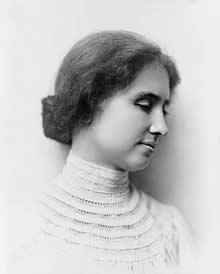The mystery of Language
 Helen Keller portrait, 1904. Due to a protruding left eye, Keller was usually photographed in profile. Both her eyes were replaced in adulthood with glass replicas for "medical and cosmetic reasons"
Helen Keller portrait, 1904. Due to a protruding left eye, Keller was usually photographed in profile. Both her eyes were replaced in adulthood with glass replicas for "medical and cosmetic reasons"
Helen Adams Keller (June 27, 1880 – June 1, 1968) was an American author, political activist, and lecturer. She was the first deaf-blind person to earn a Bachelor of Arts degree. She campaigned for women's suffrage, labor rights, socialism, anti-militarism, and other similar causes. The story of Keller and her teacher, Anne Sullivan, was made famous by Keller's autobiography, The Story of My Life
|